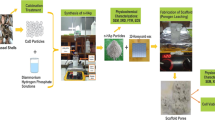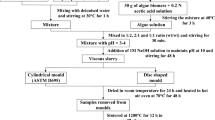Abstract
The properties of a bone scaffold not only contribute to providing the physico-chemical and mechanical support but also play a vital role to support cell adhesion, proliferation and differentiation. Many a time due to the lack in the desired properties, implanted bone scaffolds fail to effectively integrate with the host tissue. Thus, appropriate selections of the biomaterials are of great significance in the process of bone scaffold development. A novel combination of Catla catla fish scales derived hydroxyapatite (HA) and biocompatible polymer PMMA is considered in this work for the fabrication of bone scaffold. HA concentration is varied from 60 to 80 wt% in the PMMA matrix to investigate its effect on the physico-chemical, mechanical and structural characteristics of the fabricated scaffolds. The acquired results signify that the scaffold with 70 wt% HA content shows optimized properties with 76 ± 0.6% porosity, 7.98 ± 0.47 MPa compressive strength, 27.8 ± 0.3 HD hardness, 186 ± 7% swelling and 5.5 ± 0.41% degradation. The obtained results meet the recommended physiological standard to guide bone tissue regeneration. The in vitro bioactivity assessment of the best-optimized scaffold indicates bone-like apatite formation on the surface of the scaffold after 28 days of SBF immersion. The SBF immersed scaffold shows the presence of Ca and P along with traces of sodium (Na) and Magnesium (Mg) with Ca/P ratio of 1.58 which is very close to the theoretical Ca/P ratio of natural bone apatite confirming its bioactive nature. The in vitro cytotoxicity evaluation of the scaffold shows 88.1 ± 3.2% cell viability making the developed scaffold potentially effective to be used in bone grafting.










Similar content being viewed by others
References
Shegarfi, H.; Reikeras, O.: Review article : bone transplantation and immune response. J. Orthop. Surg. 17, 206–211 (2009)
Mathieu, L.M.; Mueller, T.L.; Bourban, P., et al.: Architecture and properties of anisotropic polymer composite scaffolds for bone tissue engineering. Biomaterials 27, 905–916 (2006)
Zhang, Z.; Teoh, S.; Hui, J.H.P., et al.: The potential of human fetal mesenchymal stem cells for off-the-shelf bone tissue engineering application. Biomaterials 33, 2656–2672 (2012)
Bhat, S.; Kumar, A.: Cell proliferation on three-dimensional chitosan–agarose–gelatin cryogel scaffolds for tissue engineering applications. J. Biosci. Bioeng. 114, 663–670 (2012)
Elisseeff, J.: Biomaterials science emerging investigators. Biomater. Sci. 2019, 454–460 (2019)
Corcione, C.E.; Gervaso, F.; Scalera, F., et al.: Highly loaded hydroxyapatite microsphere/PLA porous scaffolds obtained by fused deposition modelling. Ceram. Int. 45, 2803–2810 (2019)
Ratner, B.D.; Hoffman, A.S.; Schoen, F.J., et al.: Biomaterials Science—An Introduction to Materials in Medicine. Elsevier (2013) https://doi.org/10.1016/C2009-0-02433-7
Killion, J.A.; Geever, L.M.; Devine, D.M., et al.: Fabrication and in vitro biological evaluation of photopolymerisable hydroxyapatite hydrogel composites for bone regeneration. J. Biomater. Appl. 28, 1274–1283 (2014)
Prabakaran, K.; Rajeswari, S.: Spectroscopic investigations on the synthesis of nano-hydroxyapatite from calcined eggshell by hydrothermal method using cationic surfactant as template. Spectrochim. Acta - Part A Mol Biomol. Spectrosc. 74, 1127–1134 (2009)
Mondal, S.; Mondal, B.; Dey, A., et al.: Studies on processing and characterization of hydroxyapatite biomaterials from different bio wastes. J Miner. Mater. Charact. Eng. 11, 55–67 (2012)
Kumar, T.S.S.; Sivakumar, M.; Kumar, N.P., et al.: Synthesis and characterization of bioactive hydroxyapatite/fluoroapatite solid solutions using corals. Bull. Mater. Sci. 18, 955–961 (1995)
Boutinguiza, M.; Pou, J.; Comesana, R., et al.: Biological hydroxyapatite obtained from fish bones. Mater. Sci. Eng. C 32, 478–486 (2012)
Deb, P.; Deoghare, A.B.: Effect of Acid, Alkali and Alkali-Acid treatment on physicochemical and bioactive properties of hydroxyapatite derived from Catla catla fish scales. Arab. J. Sci. Eng. 44, 7479–7490 (2019). https://doi.org/10.1007/s13369-019-03807-9
Ghomi, H.; Fathi, M.H.; Edris, H.: Preparation of nanostructure hydroxyapatite scaffold for tissue engineering applications. J. Sol-Gel. Sci. Technol. 58, 642–650 (2011)
Javadinejad, H.R.; Rizi, M.S.; Aghababaei, E., et al.: Thermal stability of nano-hydroxyapatite synthesized via mechanochemical treatment. Arab. J. Sci. Eng. 41, 4401–4408 (2017). https://doi.org/10.1007/s13369-017-2498-y
Tadashi, K.; Takadama, H.: How useful is SBF in predicting in vivo bone bioactivity ? Biomaterials 27, 2907–2915 (2006)
Destainville, A.; Champion, E.; Assollant, D.B., et al.: Synthesis, characterization and thermal behavior of apatitic tricalcium phosphate. Mater. Chem. Phys. 80, 269–277 (2003)
Meejoo, S.; Maneeprakorn, W.; Winotai, P.: Phase and thermal stability of nanocrystalline hydroxyapatite prepared via microwave heating. Thermochim Acta 447, 115–120 (2006)
Han, J.K.; Song, H.Y.; Saito, F., et al.: Synthesis of high purity nano-sized hydroxyapatite powder by microwave-hydrothermal method. Mater. Chem. Phys. 99, 235–239 (2006)
Barua, E.; Das, A.; Pamu, D., et al.: Effect of thermal treatment on the physico-chemical properties of bioactive hydroxyapatite derived from caprine bone bio-waste. Ceram. Int. 45, 23265–23277 (2019)
Shi, Y.; Liu, J.; Yu, L., et al.: β -TCP scaffold coated with PCL as biodegradable materials for dental applications. Ceram. Int. 44, 15086–15091 (2018)
Rincón-López, J.A.; Hermann-muñoz, J.A.; Giraldo-betancur, A.L., et al.: Synthesis, characterization and in vitro study of synthetic and bovine-derived hydroxyapatite ceramics : a comparison. Materials 11, 333 (2018)
Woodard, J.R.; Hilldore, A.J.; Lan, S.K., et al.: The mechanical properties and osteoconductivity of hydroxyapatite bone scaffolds with multi-scale porosity. Biomaterials 28, 45–54 (2007)
Keyvan, R.-M.; Fathi, A.; Rabiee, S.M.: Three-dimensional laser drilling of polymethyl methacrylate (PMMA) scaffold used for bone regeneration. Int. J. Adv. Manuf. Technol. 84, 2649–2657 (2016)
Karageorgiou, V.; Kaplan, D.: Porosity of 3D biomaterial scaffolds and osteogenesis. Biomaterials 26, 5474–5491 (2005)
Akram, M.; Ahmed, R.; Shakir, I., et al.: Extracting hydroxyapatite and its precursors from natural resources. J. Mater. Sci. 49, 1461–1475 (2014)
Zhang, K.; Fan, Y.; Dunne, N., et al.: Effect of microporosity on scaffolds for bone tissue engineering. Regen. Biomater. 5, 115–124 (2018)
Ashworth, J.C.; Best, S.M.; Cameron, R.E.: Quantitative architectural description of tissue engineering scaffolds. Mater. Technol. 29, 281–295 (2014)
Gariboldi, M.I.; Best, S.M.: Effect of ceramic scaffold architectural parameters on biological response. Front. Bioeng. Biotechnol. 3, 54254 (2015). https://doi.org/10.3389/fbioe.2015.00151
Li, S.H.; De Wijn, J.R.; Layrolle, P., et al.: Synthesis of macroporous hydroxyapatite scaffolds for bone tissue engineering. J. Biomed. Mater. Res. 61, 109–120 (2002)
Mao, D.; Li, Q.; Bai, N., et al.: Porous stable poly (lactic acid)/ethyl cellulose/hydroxyapatite composite scaffolds prepared by a combined method for bone regeneration. Carbohydr Polym. 180, 104–111 (2018)
Hayati, A.N.; Hosseinalipour, S.M.; Rezaie, H.R., et al.: Characterization of poly(3-hydroxybutyrate)/nano-hydroxyapatite composite scaffolds fabricated without the use of organic solvents for bone tissue engineering applications. Mater. Sci. Eng. C 32, 416–422 (2012)
Smallman, R.E.; Bishop, R.J.: Strengthening and toughening. In: Modern Physical Metallurgy and Materials Engineering, pp. 259–296. Elsevier (1999). https://doi.org/10.1016/B978-075064564-5/50008-2
Eilbagi, M.; Emadi, R.; Raeissi, K., et al.: Mechanical and cytotoxicity evaluation of nanostructured hydroxyapatite-bredigite scaffolds for bone regeneration. Mater. Sci. Eng. C 68, 603–612 (2016)
Yoshikawa, H.; Myoui, A.: Bone tissue engineering with porous hydroxyapatite ceramics. J. Artif. Organs 8, 131–136 (2005)
Du, J.; Zuo, Y.; Lin, L., et al.: Effect of hydroxyapatite fillers on the mechanical properties and osteogenesis capacity of bio-based polyurethane composite scaffolds. J. Mech. Behav. Biomed. Mater. 88, 150–159 (2018)
Tripathi, G.; Basu, B.: A porous hydroxyapatite scaffold for bone tissue engineering: physico-mechanical and biological evaluations. Ceram. Int. 38, 341–349 (2012)
Guo, Z.; Yang, C.; Zhou, Z., et al.: Characterization of biodegradable poly(lactic acid) porous scaffolds prepared using selective enzymatic degradation for tissue engineering. RSC Adv. 7, 34063–34070 (2017)
Gao, C.; Hu, X.; Hong, Y., et al.: Photografting of poly(hydroxylethyl acrylate) onto porous polyurethane scaffolds to improve their endothelial cell compatibility. J. Biomater. Sci. Polym. Ed. 14, 937–950 (2003)
Deb, P.; Barua, E.; Deoghare, A.B., et al.: Development of bone sca ff old using Puntius conchonius fi sh scale derived hydroxyapatite : physico-mechanical and bioactivity evaluations. Ceram Int. 45, 10004–10012 (2019)
Czikó, M.; Bogya, E.S.; Barabás, R., et al.: In vitro biological activity comparison of some hydroxyapatite-based composite materials using simulated body fluid. Cent. Eur. J. Chem. 11, 1583–1598 (2013)
Sarma, B.K.; Das, A.; Barman, P., et al.: Biomimetic growth and substrate dependent mechanical properties of bone like apatite nucleated on Ti and magnetron sputtered TiO2 nanostructure. J. Phys. D Appl. Phys. 49, 145304 (2016)
Andrea, J.; Hermann-muñoz, J.A.; Id, A.L.G., et al.: Synthetic and bovine-derived hydroxyapatite ceramics : a comparison. Materials (2018). https://doi.org/10.3390/ma11020333
Mu, F.A.; Mu, L.: Preferred growth orientation of biomimetic apatite crystals preferred growth orientation of biomimetic apatite crystals. J. Cryst. Growth 304, 464–471 (2007)
Chen, D.Z.; Tang, C.Y.; Chan, K.C., et al.: Dynamic mechanical properties and in vitro bioactivity of PHBHV/HA nanocomposite. Compos. Sci. Technol. 67, 1617–1626 (2007)
Shahbazi, S.; Zamanian, A.; Pazouki, M., et al.: Introducing an attractive method for total biomimetic creation of a synthetic biodegradable bioactive bone scaffold based on statistical experimental design. Mater. Sci. Eng. C. 86, 109–120 (2018). https://doi.org/10.1016/j.msec.2017.12.033
Priyadarshini, U.A.B.; Grace, A.N.: Fabrication and characterization of Ag doped hydroxyapatite- polyvinyl alcohol composite nano fibers and its in vitro biological evaluations for bone tissue engineering applications. J. Sol-Gel. Sci. Technol. 81, 750–761 (2017)
Acknowledgements
The authors would like to acknowledge SAIF, Gauhati University, SAIF, IIT Madras, IIT Guwahati, CIF, NIT Silchar and for the analysis of the samples. The authors would like to thank TEQIP III and Indovation Lab, NIT Silchar for providing technical and financial support for the characterizations of the samples. The authors also acknowledge MHRD, Govt. of India, for giving monetary assistantship to complete the experimental work.
Funding
This research did not receive any specific grant from funding agencies in the public, commercial or not-for-profit sectors.
Author information
Authors and Affiliations
Corresponding author
Ethics declarations
Conflict of interest
The authors confirm that there are no known conflicts of interest associated with this publication, and there has been no significant financial support for this work that could have influenced its outcome.
Rights and permissions
Springer Nature or its licensor (e.g. a society or other partner) holds exclusive rights to this article under a publishing agreement with the author(s) or other rightsholder(s); author self-archiving of the accepted manuscript version of this article is solely governed by the terms of such publishing agreement and applicable law.
About this article
Cite this article
Deb, P., Das Lala, S., Barua, E. et al. Physico-Mechanical and Biological Analysis of Composite Bone Scaffold Developed from Catla catla Fish Scale Derived Hydroxyapatite for Bone Tissue Engineering. Arab J Sci Eng 49, 27–41 (2024). https://doi.org/10.1007/s13369-023-07872-z
Received:
Accepted:
Published:
Issue Date:
DOI: https://doi.org/10.1007/s13369-023-07872-z




